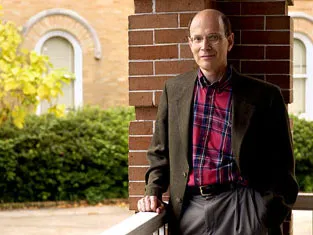
My wife, Rose, and I have just returned from a month in Yorkshire, where I went to do research for a book on British liberal politics and foreign policy from 1830-1865. I have completed work on the two Liberal party heavyweights of the period, Lord John Russell and Lord Palmerston, as well as several others, like Lord Melbourne, William Gladstone, Richard Cobden, John Bright, and Lord Aberdeen. This time I went to the University of York to look at the papers of Sir Charles Wood. He was a member of every Liberal government between 1846 and 1874 (and the Liberals governed for most of those years), and the positions he held were important ones. He was Chancellor of the Exchequer, First Lord of the Admiralty, twice Secretary of State for India and held a peerage as the first Viscount Halifax. Both his son and grandson also went on to have significant political careers. The Woods, therefore, are a significant family, reflecting the political power of the British aristocracy in the nineteenth and first half of the twentieth centuries.
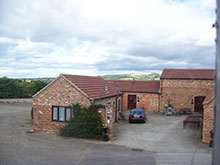
As they are from Yorkshire, and donated their papers to the University of York, Rose and I settled to a farm in Yorkshire to allow me to delve into their history. We were staying on Mill Farm in the village of Yapham, about 10 miles east of York. The farm buildings (the barn and stables) had been converted into apartments to be rented to vacationers who want to be near York, the North Sea coastal resort towns of Yorkshire, and the North Yorkshire Moors—all great tourist sites. However, it is also still very much an active farm, and Rose and I got to know the owners, both in their 80s, very well. The only way I could check e-mail was to use their nine-year old computer, and every time I turned the computer on, it crashed. Eventually I learned that once it was warmed up, the computer did fine, and since Ernest and Margaret wanted to talk, I would go to their house early in the evening, turn on the computer and let it sit, turned on, after it had crashed, and talk with them for half an hour or more. Then I could use the computer without difficulty.
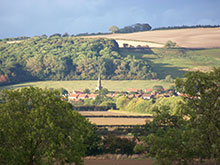
During our first week there in early September, they were getting in the wheat harvest. Ernest had hired a combine to do the job, and the threshed grain was dumped on a paved area next to the stable and barn complex where we were staying, eventually to be picked up by a truck and taken off to a warehouse. On Tuesday evening, after Rose had picked me up at the university, we went outside to watch and got into our first conversation with Ernest. When I told him I was working on the first Viscount Halifax, he pointed across his fields to a village (Bishop Wilton) and some hills in the distance and told us that all that land belonged to the Earl of Halifax. Ernest’s father had been a tenant of Halifax, and Ernest remembered the first Earl well. (He died in 1959, when Ernest was in his 30s.) The house Ernest grew up in is very prominent just outside the gates of the Halifax family estate at the foot of Garrowby Hill on the A166.
Talking with Ernest and Margaret, Rose and I saw first-hand the traditional deference paid to the aristocracy in rural England. For Ernest and Margaret had nothing but the fondest memories of the earls over the years and all the many kindnesses the family had showed them and their family. Margaret showed us a family picture album that she had put together, with pictures going back nearly to the middle of the nineteenth century and the beginning of photography, and inside it she has memorabilia of the Halifaxes. She has Christmas cards that Lord Irwin had sent to Ernest’s family when he was Viceroy. The Christmas card was the quintessence of British imperialism: a photo of the extended Wood family (there were about 15 or so people in the picture in the two cards we saw) in two rows, one sitting and one standing behind, on the patio in front of the Viceroy’s palace in New Delhi. Also among Margaret’s souvenirs are programs from dinners held to honor the oldest son upon his coming of age. The program includes the menu (substantial) and the toasts (with those proposing), starting with the Queen and concluding with a toast by a man whom I took to be a representative of the estate to the Earl of Halifax.
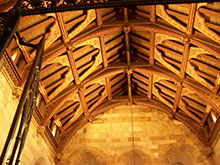
Bishop Wilton literally belonged to the Earls of Halifax (i.e., they owned all the property of the village), and Ernest and Margaret told Rose and me that we had to go to see the church, which dated back to the thirteenth century and was one of many East Yorkshire parish churches that had been restored by the Tatton Sykes family in the nineteenth century. It really is very lovely (and since it was dedicated to St. Edith, my mother’s name, I felt that there was something appropriate about our visit), but after we were finished looking at it, we both had to go to the bathroom. So we walked over to the Fleece Inn, the local pub. I went into the men’s room, and there facing me over the toilet were pictures of Sir Charles Wood and his wife Lady Mary (daughter of the Second Earl Grey, the Prime Minister who passed the Great Reform Act of 1832). I dragged Rose into the men’s room, both so she could see who I was working on and because I thought it was so hilarious that these pictures were in the men’s room.
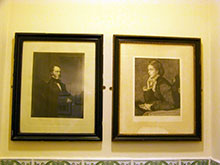
There was another way in which I saw British history close up during my stay on Mill Farm. There is perhaps a tendency for Americans to think of tenant farmers as poor and oppressed, our images shaped by Irish tenants before the Famine or share-croppers in the American South. However, in the aftermath of the enclosures of the eighteenth century, British tenant farms often were substantial in size and the farmers were prosperous, at least until the agricultural depression that was fairly continuous from the late 1870s to the Second World War. It is clear that Ernest came from such a background; his father was a dairy farmer, and one look at his fairly sizeable house shows that he did well. I suspect that Margaret came from a similarly prosperous background. Buried (literally) in the East Yorkshire Wolds is Wharram Percy, a deserted medieval village. It is best seen from the air, so that the outlines of all the buried ruins can be seen; all that remains above ground is the ruined church. However, there still is a Wharram Percy farm (I would guess for raising sheep), and it turns out that Margaret’s uncle had bought it as a 1000-acre farm when she was young. Furthermore, Ernest and Margaret had enough capital for them to purchase Mill Farm in the early 1950s. These purchases reflect one last point about England’s recent agricultural history. The agricultural depression, along with death duties (inheritance taxes) and the declining status of land, led some in the aristocracy to sell off peripheral properties, and farmers like Ernest were able to buy their own land in the years between the wars and after the Second World War. English agriculture today is doing well—something that was very evident to Rose and me as we drove around East Yorkshire. Membership in the European Union since 1972, with the subsidies provided to farmers through the Common Agricultural Policy, has been an enormous benefit to the English, who were fairly efficient farmers anyway. My experience staying on the Mill Farm in Yapham showed me this and a lot more of the history I have been teaching over the past thirty years. It added an extra dimension of both interest and fun to my research trip to Yorkshire. (There are nice Wikipedia articles on Wharram Percy medieval village and the Sykes Churches Trail.)

